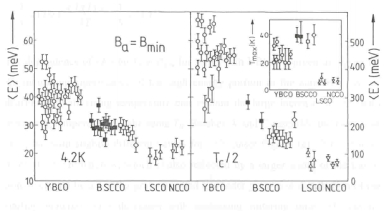One of the obstacles of the application of high temperature superconductors (HTS) in high current
applications is the weak pinning in this type of materials. The reason for this behaviour is mainly the small coherence
length and the high anisotropy of HTS. A consequence of the weak pinning is the appearance of large flux creep effects.
Investigation of the flux creep by magnetic relaxation measurements are going in two directions:
- In measuring the time dependence of the magnetization information about the pinning mechanisms can be gained.
Theoretical models describing the pinning process can be tested. Magnetic phase diagrams for the different superconductors can be obtained.
- Investigation of the influence of the preparation process on the pinning behaviour allows to develop new preparation routes for superconductors
with improved current carrying abilities (e.g. hot plastic deformation)
|
High temperature superconductors

Fig.2: Comparison of mean effective activation energy for the different classes of high temperature superconductors:
YBCO, BSCCO (2223, 2212), Tl2223, LSCO and NCCO.
Inset: Temperature of the maximum in the normalized creep rate measured in Ba = Bmin
|


